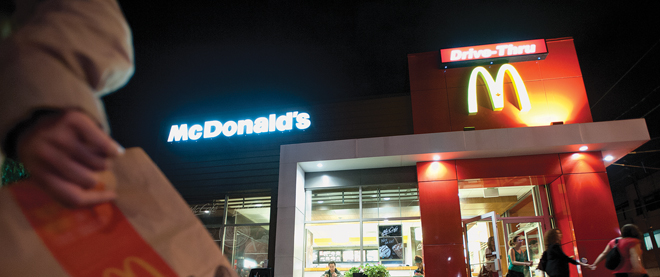McDonald’s seeks ‘nocturnivores’ for midnight breakfast
Marketing to the late-night crowd, many of them inebriated males, is a delicate task for the family-oriented brand
Photograph by Cole Garside
Share

At 1:45 on Sunday morning, three backpack-wearing young men are crowded around a drive-through speaker outside of a 24/7 McDonald’s in Ottawa. “We’re pretty drunk,” admits one, an 18-year-old Queen’s University engineering student. After playing a game of rugby earlier in the evening and then drinking at a house party, they’re craving Big Macs. McDonald’s is hoping the gang might soon be interested in another kind of meal at this hour: breakfast.
In early August the company launched a “Breakfast after midnight” menu, available in Denver, Boston and throughout Ohio between midnight and 5 a.m. The time period is known as the “final frontier” in the fast food business, and McDonald’s is competing with other brands to conquer the demographic most likely to be awake: young—sometimes inebriated—males. A survey by Taco Bell found nearly 45 per cent of its male customers between 18 and 29 years old eat later than 7 p.m. But the chain famous for its smiling clown has a unique challenge in reaching this audience: how to attract partygoers without offending its core audience—moms and families?
CBC host and marketing expert Terry O’Reilly recently dubbed the trend “stoner ads.” Taco Bell’s “fourth meal” campaign, which showcases its menu to a “late-night munchies” jingle has been around for several years, and more recently companies such as Jack in the Box and Denny’s have featured stoners in their commercials (in the latter case, a unicorn). This summer, Loud Mouth Burritos, an upstart U.S. company, said it would market to pot smokers, touting that each burrito has 420 calories—a number universally associated with cannabis culture.
McDonald’s, meanwhile, has opted for a more ambiguous approach. The company has dubbed its target client a “Nocturnivore.” Its ads show simple images of french fries or the golden arches with messages such as “Loved around the world. And around the clock” or “The moon is full. You should be too.” According to the Wall Street Journal, midnight to 5 a.m. is the fastest-growing time segment for U.S. McDonald’s locations, and though the hours of 2 a.m. to 5 a.m. only represent one per cent of total fast-food traffic, there is opportunity for growth. Any profit would be incremental, but McDonald’s could use a boost: global sales were flat in July and fell by 0.1 per cent at U.S. locations, its worst performance in more than nine years. Though the company hasn’t been aggressive in marketing to the after-hours crowd, nearly 40 per cent of its U.S. outlets are now open around the clock—meaning the infrastructure is already in place to compete against other chains that directly appeal to young males. But will its ambiguous campaign be sufficient to capture their attention? It will have to do. “McDonald’s has never had an edge to it,” says Kerry Harris, a brand strategist who for four years was president of PR firm Weber Shandwick’s Canadian office, where her largest client was McDonald’s. “The key brand attribute is a wholesome, family, community-based environment—none of that speaks to stoner ads.”
Instead of using a targeted message, the company is advertising on videogames and in pedicabs—hoping to reach young people where they are without messing with the family brand McDonald’s has fostered with healthier menu options, better coffee and swankier dining rooms. Denise Lee Yohn, a brand strategy consultant who has worked with Burger King and Jack in the Box, says the covert advertising approach will work. “[‘Nocturnivore’] is up for interpretation and maybe that’s the brilliance,” she says. “Certain people will understand what it means, and everyone else will think it’s innocuous.” Similarly, rather than creating an overt “munchies menu,” Yohn says using the breakfast items is a crafty way for the company to entice a new demographic without affecting the core brand perception.
Not all experts think juggling clientele will be an issue. Neil Lester, founder of FirstOak Hospitality Consulting says, “Breakfast after midnight” will primarily appeal to working people who don’t want a burger. McDonald’s spokesperson Danya Proud told the Chicago Tribune, “customers are commuting longer, people are out at different hours.” It’s the same story here: commutes are up and 30 per cent of Canadians work non-standard hours, according to Statistics Canada.
While Harris agrees McDonald’s will attract a working demographic, she maintains young people are the obvious target for late-night eats. “They are the low-hanging fruit,” Harris says. “That’s who is most likely to be out and about at that hour.”
Will they bite? The boys in line for burgers in Ottawa nod in unison at the prospect of breakfast in the wee hours. “The Sausage McMuffin is the best of the best,” says another Queen’s student. “In all circumstances, with hash browns, it’s the best.”